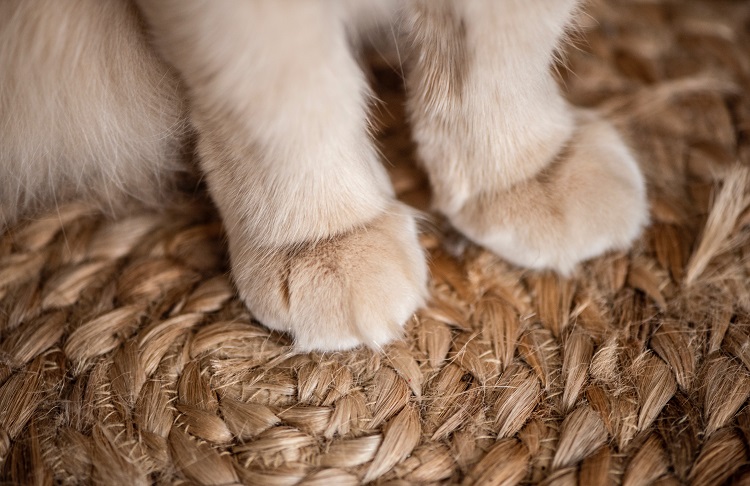Most breeds of cats are known for being playful and active. But with all the fun and games comes the depreciation of their paws. Their body also needs care and grooming, such as brushing hair, trimming nails, and cleaning. They don’t require any special treatments but just the basic needs for keeping tidy and healthy.

Contents
Cat Paw Care Tips
Below given are The measures you should take up to keep your cat’s paws clean and healthy.
1. Keep Your Cat’s Paws Clean
When playing around, your cat may collect the dirt on its paws from different places. This collection of dirt and debris may contain harmful substances that can cause it to become sick. These toxic substances or infectious microorganisms can also pave their way through the mouth when a cat licks its paws.
To prevent any infection:
> Clean the paws with a damp and clean napkin or cloth.
> Remove any particles or even liquid substances stuck on its paws because it could be damaging.
> Dip its paws in medium warm water and then wipe with a cloth.
2. Check Their Paws For Injury
Sometimes while jumping around, they may land on an object that causes scratches, cuts, or injury on their paws. It can make way for infectious agents to enter the body and cause illness. They might also cause pain or discomfort to your cat.
To avoid this, always remember to check if there’s any injury while cleaning the paws. If you find one, apply the appropriate ointment and remove if there’s any object stuck in the paws. If your cat is in pain or the injury is serious, take it to the vet.
3. Keep Your Cat’s Nails Trimmed
It is important to trim your cat’s nails every week or two. It is not extremely essential, but it is considered important for your pet’s health. It is also a good idea to protect your furniture and skin from scratches.
It takes a tad more effort to trim the nails. Seat your pet comfortably somewhere and take help if you’re required to tackle it. When it opens the claws, cut the white part gently and not the pink part if you do not want it to bleed.
Use a sharp trimmer, and don’t worry if you are not able to complete it in one go. It does take a few sittings, especially if you are new to it. If you don’t feel comfortable cutting them on your own, you can take them to the vet to get the job done.
4. Watch For Infection
It is possible for the harmful agents or toxins released by them to enter the body through cuts in the skin or even nails. If you notice symptoms related to infections such as swelling, bleeding, pain, vomiting, indigestion, lethargy, loss in appetite, or skin lesions, take your pet to the vet for the treatment to begin as soon as possible.
5. Watch For Limping
Sometimes, you might notice your cat limping on one leg. It may occur due to some trauma or injury on the other leg. Your cat could also be in pain, and it could be something as severe as debilitation of joints, bones, muscles, or nerves.
Foreign objects stuck in the paw could also lead to such a condition. To avoid worsening the condition, you must rush it to the vet as soon as possible.
6. Know the Signs Of Pillow Foot
Pillow Foot is a rare, auto-immune condition that causes the inflammation of the footpad along with the accumulation of Plasma Cells. It is scientifically known as Plasma Cell Pododermatitis.
The foot of the cat is puffed up in appearance, and it can become very painful in advanced cases. The paw becomes swollen and tender to touch. If you see the symptoms of Pillow Foot in your cat, take it to the vet to rescue it from the discomfort and pain.
7. Do Not Declaw Your Cat
Declawing cats is basically the removal of the claws. It sounds like a benign and simple process, but it actually involves the removal of the last bones of the feline’s toes.
It is a painful procedure carried out using a scalpel or guillotine clipper. It can leave your cat in a crippling condition. Nails start growing inside the paw, which can be extremely painful. In some places, it is considered cruel, and vets refuse to perform it.
Conclusion
Your cat requires cleaning its paws regularly and keeping them in a healthy condition. It protects it from diseases and infections. While cleaning, you might even detect injury or scratches, which should be treated with medication. Injuries can become a loophole for the destructive agents to gain access to the body’s tissues.
If you find any signs or symptoms of infections such as swelling of paws, bleeding, lethargy, and others, you must consult the vet. Pillow Foot can also be caused, which can cause the mushy appearance of the foot and is painful. Such conditions should be treated as soon as possible.
In any case, avoid declawing the paw because it leaves your pet in extreme suffering. Nails should also be trimmed regularly with a sharp cutter. Such things should be kept in mind for proper care of your cat’s paws, pads, and nails.






![DNS_Probe_Finished_No_Internet Error [RESOLVED] Fix DNS_Probe_Finished_No_Internet Error](https://howandwow.info/wp-content/uploads/2019/09/Fix-DNS_Probe_Finished_No_Internet-Error.jpg)
![Err_Connection_Reset Error in Chrome [RESOLVED] Fix Err_Connection_Reset Error in Google Chrome](https://howandwow.info/wp-content/uploads/2019/09/Fix-Err_Connection_Reset-Error-in-Google-Chrome.jpg)
![Err_Cache_Miss in Google Chrome Error [RESOLVED] Err_Cache_Miss in Google Chrome Error](https://howandwow.info/wp-content/uploads/2019/08/How-to-Fix-Confirm-Form-Resubmission-Error.jpg)









![Steam Missing File Privileges Error [RESOLVED] How to Fix Steam Missing File Privileges](https://howandwow.info/wp-content/uploads/2020/07/How-to-Fix-Steam-Missing-File-Privileges-Error-100x70.jpg)
![SIM Not Provisioned MM#2 Error [RESOLVED] SIM Not Provisioned MM#2](https://howandwow.info/wp-content/uploads/2020/03/SIM-Not-Provisioned-MM2.jpg)








